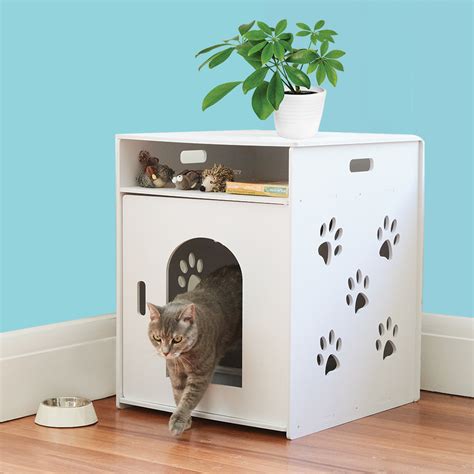Introduction

Cat litter is an essential part of cat ownership, providing a safe and clean place for cats to eliminate waste. However, many cat owners are unaware of the potential health risks associated with cat litter, particularly in terms of respiratory and allergic reactions. This article aims to provide cat owners with information on the latest innovations in cat litter technology and to educate them on the health implications of cat litter choice.
Types of Cat Litter and Their Health Implications
There are various types of cat litter available, each with its own benefits and drawbacks.
-
Clay Litter: Traditional clay litter is highly absorbent and clumps well, making it easy to scoop and clean. However, clay litter can be dusty, which can irritate the respiratory tract of both cats and humans.
-
Silica Gel Litter: Silica gel litter is highly absorbent and does not produce dust, making it a good choice for cats with respiratory issues and allergies. However, silica gel litter can be more expensive than other types of litter.
-
Natural Litter: Natural litter, such as pine pellets or wheat litter, is biodegradable and environmentally friendly. However, natural litter may not be as absorbent as other types of litter and can be more difficult to clean.
Health Risks Associated with Cat Litter
In addition to respiratory irritation, cat litter can also pose other health risks:
-
Toxoplasmosis: Toxoplasmosis is a parasite that can be found in cat feces. If ingested, toxoplasmosis can cause flu-like symptoms in humans, and it can be particularly dangerous for pregnant women and people with weakened immune systems.
-
Bacterial Infections: Cat litter can harbor bacteria, such as Salmonella and E. coli, which can cause infections in humans and cats if ingested or inhaled.
Innovations in Cat Litter Technology
The cat litter industry is constantly evolving, with new innovations emerging to address the health concerns associated with cat litter.
-
Dust-Free Litter: Several brands now offer dust-free cat litter, which can help to minimize respiratory irritation in both cats and humans.
-
Antimicrobial Litter: Antimicrobial litter contains ingredients that help to kill bacteria and prevent the spread of infections.
-
Self-Cleaning Litter Boxes: Self-cleaning litter boxes automatically scoop and dispose of waste, reducing the amount of exposure to litter for both cats and owners.
Health Education for Cat Owners
In addition to choosing the right cat litter, there are several other steps cat owners can take to protect their health:
-
Regularly clean the litter box: Scoop the litter box daily and dispose of waste in a sealed bag.
-
Wash your hands: Always wash your hands after handling cat litter or cleaning the litter box.
-
Keep the litter box in a well-ventilated area: This will help to reduce the spread of dust and bacteria.
-
Avoid using scented litter: Scented litter can be irritating to the respiratory tract of both cats and humans.
-
Consider using a dustpan specifically for cat litter: This will help to reduce the amount of dust that escapes into the air when cleaning the litter box.
Common Mistakes to Avoid
-
Leaving soiled litter in the litter box for too long: This can contribute to the growth of bacteria and the spread of disease.
-
Using too little litter: This can make it difficult for cats to bury their waste, which can lead to litter box avoidance and other behavioral problems.
-
Using the same litter box for multiple cats: This can increase the risk of spreading infections.
-
Not changing the litter box often enough: Over time, litter can become contaminated with urine and feces, which can be harmful to cats’ health.
FAQs
-
What is the best type of cat litter for my cat? The best type of cat litter for your cat will depend on their individual needs and preferences. If your cat has respiratory issues or allergies, you may want to consider a dust-free or silica gel litter. If you are concerned about environmental friendliness, you may want to consider a natural litter.
-
How often should I change my cat’s litter box? You should scoop the litter box daily and dispose of waste in a sealed bag. The entire litter box should be changed every week or two.
-
What are the signs of a cat litter allergy? Signs of a cat litter allergy can include sneezing, coughing, wheezing, itchy eyes, and a runny nose. If you think your cat may be allergic to their litter, talk to your veterinarian.
-
Can cat litter cause toxoplasmosis? Yes, cat litter can contain Toxoplasma gondii, a parasite that can cause toxoplasmosis. If you are pregnant or have a weakened immune system, you should avoid handling cat litter and wear gloves if you must.
-
How can I reduce the risk of bacterial infections from cat litter? Regularly clean the litter box, wash your hands after handling cat litter, and keep the litter box in a well-ventilated area.
-
Is scented cat litter harmful to my cat? Scented cat litter can be irritating to the respiratory tract of both cats and humans. It is best to avoid using scented litter.
Conclusion
Cat litter is an essential part of cat ownership, but it is important to be aware of the potential health risks associated with cat litter choice. By choosing the right cat litter and following the health education tips outlined in this article, cat owners can help to protect the health of their feline friends and their own.





















